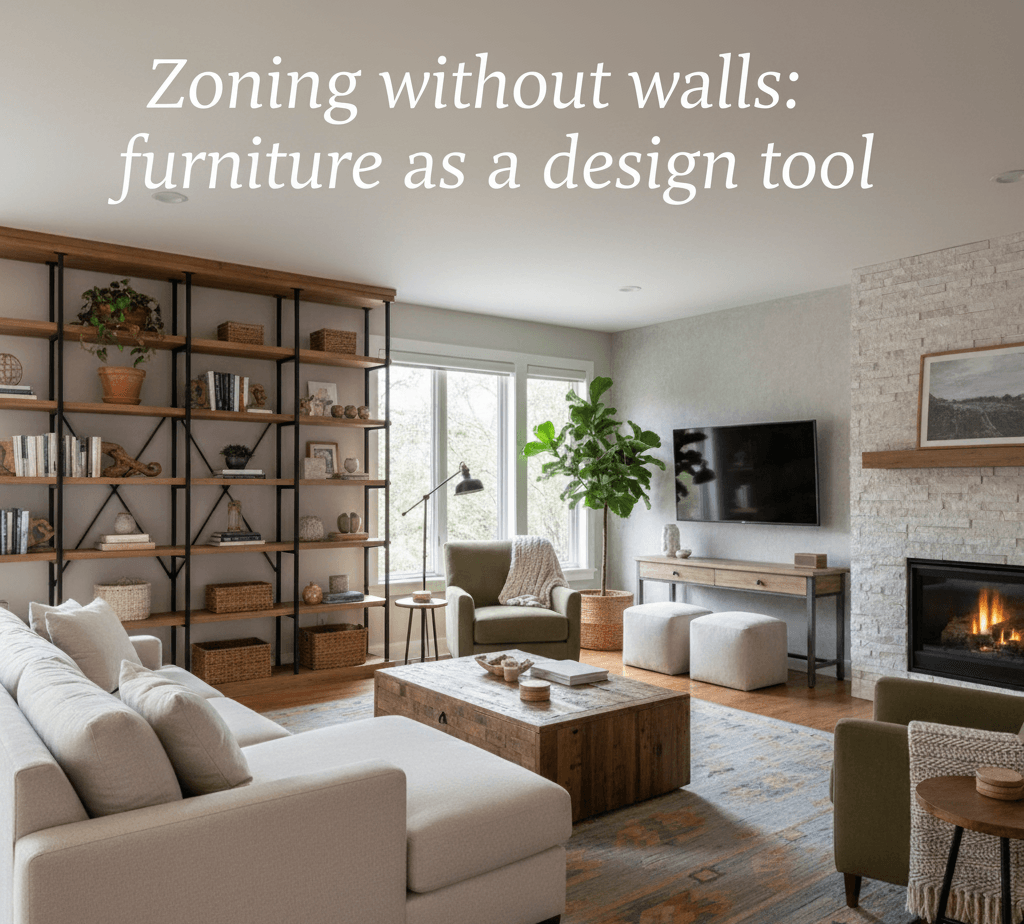10 Ideas for Stylish Space Zoning at Home

Sometimes an apartment feels cramped not because of the square footage but because of chaos. Rooms just melt into each other, and it’s impossible to tell where the kitchen ends and the living room begins. People spend years trying to “arrange everything properly,” but without clear borders, the space feels accidental. Zoning fixes that. And no, it’s not always about walls or heavy partitions. There are countless tricks — from rugs to light, and some unexpected hacks in between.
1. Furniture as Architecture
You don’t need drywall. You don’t need some dusty contractor hammering away for three weeks. Put the sofa in the middle of the room and—boom—it’s a divider. Its back says: this side is for lounging, that side is for eating or working or whatever you decide tomorrow.
The dining table can do the same job. Spin it sideways, let it cut through the room like a barrier. Suddenly there’s order in the chaos. People underestimate how strong a single piece of furniture can be—like a chess piece that shapes the whole game.
I once shoved a bookshelf behind my couch. Not because I needed more shelves (I did, but that’s not the point). It became a wall. A fake wall, but a damn good one. Friends walked in and just assumed it was meant to be like that. So yeah, furniture isn’t just furniture. It’s sneaky architecture.
2. Rugs and Textiles
A rug is basically a stage. Lay one down and the actors know where to stand. Without it the room feels like a waiting hall, everyone just floating around. With it? Living room. Dining zone. Reading nook. It’s witchcraft, really.
Patterns crank the mood. A sharp zigzag makes a dining spot electric. A faded wool rug whispers relax, sit down, take a breath. Swap one rug and the whole room flips personality like a moody teenager. Light linen in July, thick shag in December—why not treat rugs like clothes, seasonal, disposable, mood-driven?
And don’t even get me started on curtains, throws, cushions. Once they start matching the rug, the space feels like it’s suddenly telling a coherent story. Sometimes I think textiles are louder than paint.
3. Color Blocking on Walls
Painting is the laziest, cheapest zoning tool. Which is why I love it. Leave one wall bright white, paint the next deep green—now you’ve got a kitchen and a lounge, even if technically they’re the same 20 square meters. No trick mirrors or overpriced partitions. Just paint.
You don’t need to cover the whole wall either. Try a rectangle behind the sofa, something bold and uneven, like a graphic poster. Or slap a weird diagonal stripe above your desk. People walk in and their brain goes, ah, that’s the workspace. No words needed.
And when you get sick of it? A roller, a can of paint, and an afternoon later—brand new zones. Cheap dopamine hit.
4. Lighting as a Marker
Light has attitude. That’s the thing nobody tells you. A single pendant over the dining table? Drama. A floor lamp in the corner? Suddenly that corner is a private reading sanctuary.
What kills me is how fast light reshapes a place. During the day everything’s washed out, unified, boring almost. At night you switch on one dim lamp and the living room shrinks, turns intimate, maybe even romantic. It’s the same square footage, but it feels like an entirely different apartment. Like the walls moved in closer.
Play with it. Layer it. Break it. Overhead light is tyranny—lamps are freedom.
5. Sliding Glass Partitions
Glass partitions are weird. They’re walls that don’t feel like walls. Offices figured this out years ago—those endless transparent boxes where managers sit pretending they’re not separated from the team. At home though, it’s magic. You get privacy without losing light.
I’ve seen them in kitchens where you can close off the smell of garlic frying, then slide them open and suddenly you’re back to one big party room. Frosted ones look slick, tinted ones feel kind of moody. Some glide silently, others clunk around on rails like old subway doors. Honestly, they’re fun. Functional too.
Do you need them? No. Will you want them after seeing good examples? Probably.
6. Curtains and textile dividers
A curtain from floor to ceiling can be pure magic. Pull it back — and the studio is one whole. Close it — and suddenly there’s a bedroom or a quiet workspace.
7. Multi-level flooring
A platform always looks impressive. Raise the lounge area just 15 cm higher, and it’s instantly separate from the kitchen. The room stays whole, but your eye gets a clear signal.
8. Open shelving
A see-through bookcase is both storage and divider. Books, vases, plants — and you’ve got something functional and stylish that splits a space beautifully.
9. Green “walls”
Tall plants like ficus or palm trees can do the job of a wall. A natural green corridor that both divides and refreshes.
Besides, greenery changes with the seasons, which makes your “wall” alive in a way drywall never could. You can even mix heights and species — big leaves at the bottom, climbing vines above — and the space starts to feel like a small indoor garden.
10. Decorative partitions
Light wooden or metal frames, sometimes geometric, sometimes minimal. Less about practicality, more about atmosphere.
They don’t need to block the view completely — even a lattice or slatted design tricks the eye into seeing two separate spaces. Plus, these partitions can double as art pieces: sculptural, playful, sometimes even conversation starters when guests come over.
Style and mood
Honestly, zoning isn’t just about function. It’s about vibe. A properly zoned apartment looks more thought-out, more “expensive.” Lately, open-plan layouts are trending, but people still crave borders. That’s the paradox — freedom on one hand, order on the other.
By the way, if you’re curious, here’s a great read about how glass partitions transform interiors — check this article.
Things to keep in mind
- Don’t overdo it — if your place is 40 m², three zoning tricks at once will suffocate it.
- Think about light — walls and curtains steal daylight, glass keeps it.
- Zoning should be “alive” — move the furniture, swap a rug, and the space shifts instantly.
Final word

I honestly think there are no “rules” here. Just tools that work for you. Some people love wide open spaces, others need cozy corners. Play around. Sometimes it takes just one rug or a glass divider to turn chaos into clarity.
And if you’re serious — take a look at glass wall systems. They give you flexibility, and that’s not marketing fluff, that’s genuinely useful.
P.S.
Yeah, I know — everyone’s got their own taste. Some say glass partitions feel cold. Others say rugs are outdated. Whatever. The only thing that matters is that your home feels right to you.
